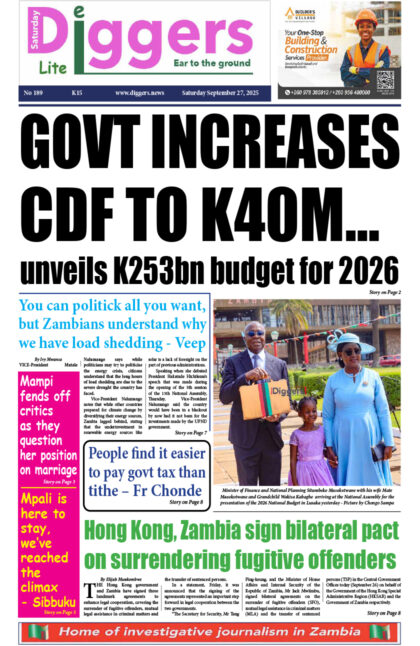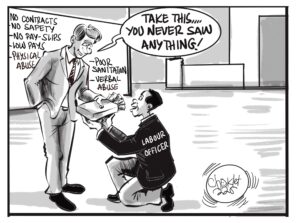The Zambian Kwacha has experienced persistent reductions in its value relative to major convertibles such as the USD. As at 7th November 2023, the local unit traded at K22.25 per dollar, lows that were last reached during the Patriotic Front regime. In the process, some of the gains that have been scored in the last 2 years are on the brink of being erased, such as the inflation rate. On a wider scale, the Kwacha has been ranked as the second worst performing currency in the world after the Argentinian Peso, having lost 21% of its value since June 2022. What has gone wrong? I will try to provide an answer.
Firstly, this unsatisfactory performance was not the expectation of Economists and Financial Analysts such as myself. Indeed, in view of the progress that has been made with the restructuring of our debt and the MOUs signed with creditors, the informed perception was that the Kwacha’s performance would improve. To the contrary, agreement with our Official Creditors on the 22nd of June, was followed only by a short-lived appreciation in value of our currency. Once that had elapsed, there ensued what should be the most prolonged period of currency depreciation under the UPND Government. Unfortunately, this is the nature of Financial Markets, at times tending to defy even Economic logic.
In response to this, the Bank of Zambia has done what is within its means to stabilize the exchange rate. Both the Monetary Policy Rate and Statutory Reserve Ratio (SRR) have been raised by 50 and 300 basis points respectively. This will slow credit growth, which will cool economic activity and reduce the amount of money in circulation.
There is more than one reason to the depreciation of the Kwacha, namely, reduced copper exports, happenings in the Global Economy and reserves held at the Central Bank. I will not belabor the first of these as it has been extensively reported. I will focus on less explored aspects, beginning with International financing conditions. To be specific, in the wake of Russia’s invasion of Ukraine, advanced economies raised their interest rates to quell the inflation caused by the conflict. Whilst, the pace of rate increases has since slowed, they are still substantially higher than pre-war levels.
What does this mean for countries such as Zambia? Well, when interest rates in advanced economies are high, investors have less of an appetite for sovereign bonds of Emerging Market and Developing Economies. Beyond Government bonds there is generalized risk aversion by international investors, who are a major source of foreign exchange. This is more pronounced the lower the credit rating of an economy. Zambia has a credit rating of CCC+ from Standards & Poors and Caa2 from Moody’s, both relatively low readings. The implication of this is that in an already unstable external environment, economies such as ours with recovering economic statuses, as reflected in our credit ratings, will see the largest decline in capital flows.
A separate cause of the Kwacha’s plummeting is the dwindling reserves at the Bank of Zambia. As at the last Monetary Policy Committee meeting, Gross Reserves were below the recommended threshold of 3 months of import cover. From $3.1 million dollars in November last year, reserves are now in the region of $2.6 million (June), effectively 2.9 Months of import cover. Bearing in mind that the last reported figure was in June, the present-day amount may be less. It is these reserves that the Bank of Zambia uses to intervene in the currency markets. However, as it does so it needs to maintain 3 months of import cover. Currently, therefore, the Bank of Zambia might be unable to provide immediate relief outside of the Monetary Policy tools.
Monetary Policy is an effective tool for controlling inflation, however, its impact is felt with a lag. It will not ease price pressures tomorrow or next month, but over time, possibly in a year or so. Therefore, the coming months will be particularly challenging with depleted reserves, reduced copper output, amidst a troubled global economic environment. This may explain the Bank of Zambia’s decision to raise the SRR by such a wide margin, desperate times calling for desperate measures.
To conclude, in making these assertions it is important to bear in mind the Zambian economy is in the process of recovery. Just as in everyday life, sometimes the economy will get worse before it gets better. I wish I could say the Kwacha will end its fall. With markets, unfortunately, however, you cannot make this statement with much certainty. Nevertheless, in the long run, improved institutional capacity, fiscal prudence and investments in the economy, will provide a foundation for resolute and robust economic growth in future, most probably in 2025 and beyond.
The Author is an Economist and Member of the Economics Association of Zambia.

























2 responses
You cannot continue to blame external factors on the fall of the kwacha because the same external factors are also affecting other African currencies but are they depreciating like our kwacha? The answer is NO because their governments have put in place measures to arrest this while ours has no clue as to what to do.
This anaysis is lop sided! External factors are part of the blame game!
You can’t have a weak kwacha with abandunce in natural resource.if foreign and local individuals are making million dollars and govt is aloof and making nothing but juggling financial jargon in the corridors of ministry of finance is incompetence. Zambia even next month could post a positive rating in performance if govt could be serious with local resource mobilisation in mineral exploitation,prudent water management,provincial maize growing for DRC market ànd doing away with so called PPP for roads which will milk away the cash flow for govt for 22 yrs.